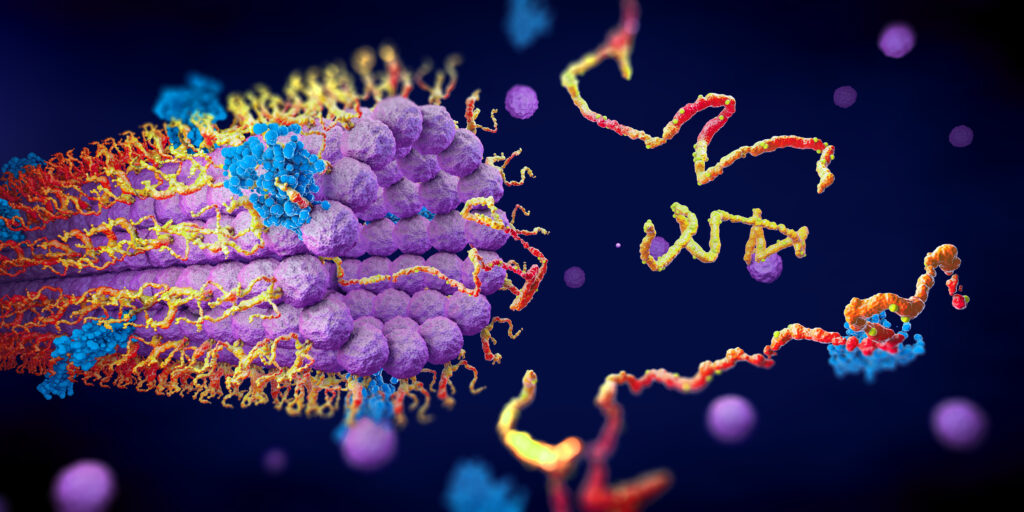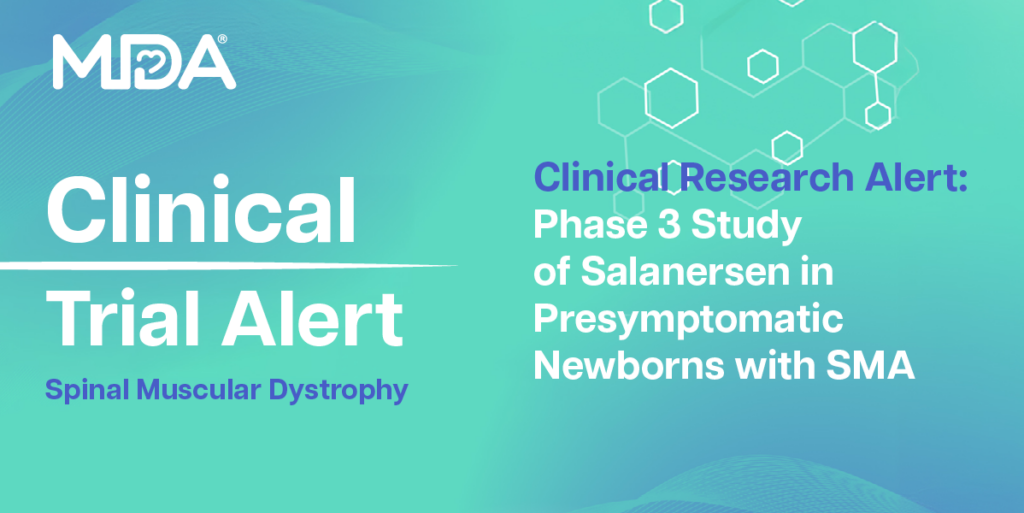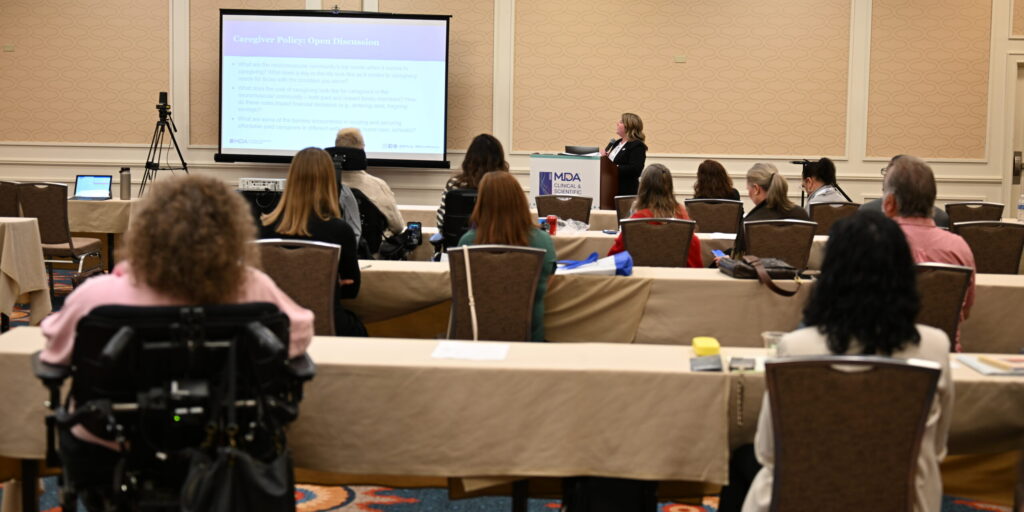
Simply Stated: Updates in GNE Myopathy
By Sujatha Gurunathan | Thursday, June 27, 2024
5 Second Summary
“Simply Stated” is a Quest column designed to explain some terms and basic facts about neuromuscular diseases.
Find more at Mdaquest.org/tag/simply-stated
GNE myopathy is an inherited neuromuscular disease (NMD) characterized by progressive atrophy (thinning) of the skeletal muscles. GNE myopathy was previously called hereditary inclusion body myopathy (HIBM) or Nonaka myopathy in some cases, until discovery of the genetic cause of the disease proved that all of these conditions were actually the same condition caused by a defect in the GNE gene. GNE myopathy is rare, with an estimated prevalence of 1-9 cases in 1,000,000 people. The disease may be more prevalent in some regions (e.g. Japan, Middle East, India), however, due to a higher frequency of the GNE gene mutations in those populations.
Symptoms of GNE myopathy
Most people with GNE myopathy start to develop symptoms between 20 and 40 years of age. The disease primarily affects the skeletal muscles that control voluntary movements. One of the earliest signs of the disease is a bilateral (both) foot drop caused by weakness of the front muscles of the lower leg (anterior tibialis muscles). Affected people go on to experience progressive muscle weakness throughout the body that worsens over decades. They may initially have difficulties such as decreased grip strength and frequent loss of balance. Notably, the quadricep muscles at the front of the thigh seem to be relatively spared in people with the disease until later stages. As the disease progresses, mobility becomes challenging, leading to the need for walking assistance and, in some cases, a wheelchair. In the late stage of the disease, some people experience breathing problems due to weakness of the respiratory muscles.
Cause of GNE myopathy
GNE myopathy is caused by mutations in the GNE gene, which encodes an enzyme known as UDP-N-acetylglucosamine 2-epimerase/N-acetylmannosamine kinase. This enzyme functions to make sialic acid, a sugar that is added to many proteins in the body and is required for many cell processes. It is not understood how defects in sialic acid production cause GNE myopathy, but the lack of sialic acid on the proteins in muscle cells likely contributes to the disease. Genetic changes that cause GNE myopathy are inherited in an autosomal recessive pattern, which means that two copies of the defective gene (one from each parent) are required to cause the disease.
Diagnosis of GNE myopathy
A diagnosis of GNE myopathy is typically based on a combination of clinical examination and genetic testing. Clinical observations, such as bilateral foot drop in a young adult, will typically lead the clinician to order a neuromuscular disease genetic testing panel. This panel can detect probable or confirmed pathogenic mutations in the GNE gene, leading to a diagnosis of GNE myopathy. In some cases, characteristic changes seen in a muscle biopsy sample, such as the presence of “rimmed vacuoles” and a lack of inflammation, can help confirm a GNE myopathy diagnosis.
Current management of GNE myopathy
There is currently no known cure or disease-modifying therapy for GNE myopathy. Regular monitoring of disease progression and muscle function by a neuromuscular specialist, in concert with rehabilitation medicine, can help identify ongoing management needs. In some cases, respiratory and cardiac care may be required to manage complications of GNE myopathy.
Several strategies are available that can help alleviate symptoms and facilitate daily life for people with GNE myopathy. These include:
- Exercise as prescribed by physical/occupational therapist (PT/OT)
- Use of ambulatory assistive devices (e.g. cane, walker, wheelchair)
- PT accommodations to assist with mobility (e.g. devices to help with transfers to and from wheelchair)
- OT accommodations to assist with activities of daily living (e.g. techniques to facilitate washing, dressing, eating, etc.)
- Household modifications to meet accessibility needs
Evolving research and treatment landscape
While the current standard of care is proactive symptom management and PT/OT accommodations, research advances and the promise of therapeutic development on the horizon offer hope for people living with GNE myopathy. The disease is caused by a defect in the body’s ability to make sialic acid, so recent drug development has been focused on increasing the levels of sialic acid in the body.
In line with this strategy, the company Ultragenyx Pharmaceutical developed an extended-release sialic acid supplement, known as Ace-ER. A phase 2 study of the investigational drug indicated that Ace-ER may stabilize muscle strength in treated patients, but the drug failed to show clinical efficacy in a phase 3 clinical trial. Ultragenyx discontinued development of Ace-ER in 2017. Supplementation strategies have also been studied by other groups. A multicenter phase 2/3 trial conducted in Japan showed that treatment with extended-release sialic acid (SA-ER) was effective in preserving upper limb muscle strength in Japanese patients with GNE myopathy. This drug has since been approved for use in Japan.
Other recent efforts have focused on introducing sialic acid precursor molecules to boost the body’s production (biosynthesis) of sialic acid. One such molecule, N-acetylmanossamine (ManNAc), is a promising therapy in development for GNE myopathy. This drug showed efficacy in early phase clinical trials and is now being studied in the pivotal phase 2 multi-center MAGiNE trial sponsored by Leadiant Biosciences, which is evaluating the long-term safety and clinical efficacy of ManNAc in people with GNE myopathy. In addition to ManNAc, the sialic acid precursor 6′-sialyllactose (6SL) has been studied in a pilot clinical trial, with positive results.
Gene therapy-based strategies to treat GNE myopathy are in preclinical studies. Researchers are working to optimize the viral (AAV)-based methods to correct the underlying gene defects in muscle tissue affected by GNE myopathy and also to develop cell and animal models in which the investigational gene therapies can be tested.
Observational research and patient registry opportunities are also ongoing to better understand the disease course of GNE myopathy and identify outcome measures that may be used for future clinical trials. The following observational study is currently recruiting individuals affected by GNE myopathy:
Sponsor: National Human Genome Research Institute (NHGRI)
Where to learn more about GNE myopathy
For more information about the signs and symptoms of GNE myopathy, as well an overview of diagnosis, prognosis, and care management concerns, an in-depth review can be found from Carrillo, et al.
MDA’s Resource Center provides support, guidance, and resources for patients and families, including information about GNE myopathy, open clinical trials, and other services. Contact the MDA Resource Center at 1-833-ASK-MDA1 or ResourceCenter@mdausa.org.
Next Steps and Useful Resources
- For more information about the GNE myopathy , an in-depth review can be found here.
- For more information about the signs and symptoms of GNE myopathy, as well an overview of diagnosis, prognosis, and care management concerns, an in-depth review can be found from Carrillo, et al.
- The following observational study is currently recruiting individuals affected by GNE myopathy:A Natural History Study of Patients With GNE Myopathy and GNE-Related Diseases (ClinicalTrials.gov ID NCT01417533)
- MDA’s Resource Center provides support, guidance, and resources for patients and families, including information about SELENON-related myopathy, open clinical trials, and other services. Contact the MDA Resource Center at 1-833-ASK-MDA1 or ResourceCenter@mdausa.org.
- Stay up-to-date on Quest content! Subscribe to Quest Magazine and Newsletter.
Disclaimer: No content on this site should ever be used as a substitute for direct medical advice from your doctor or other qualified clinician.




